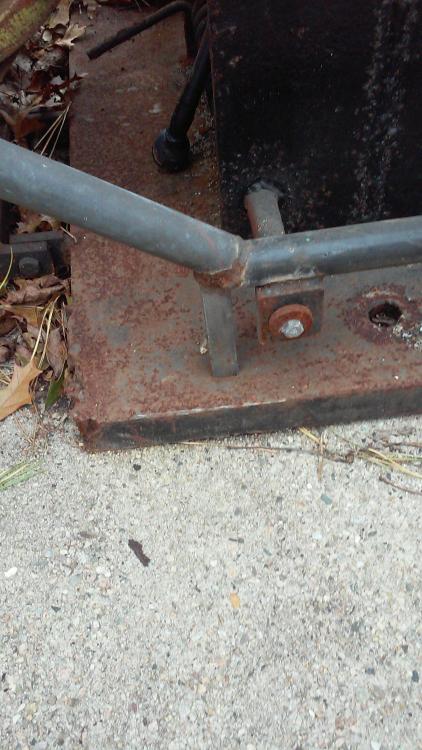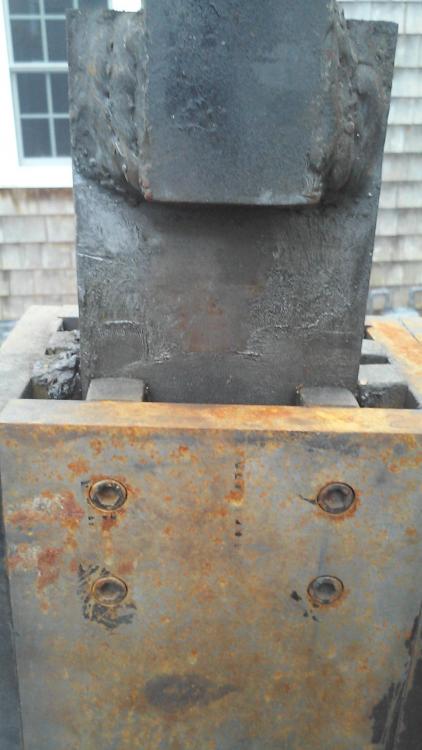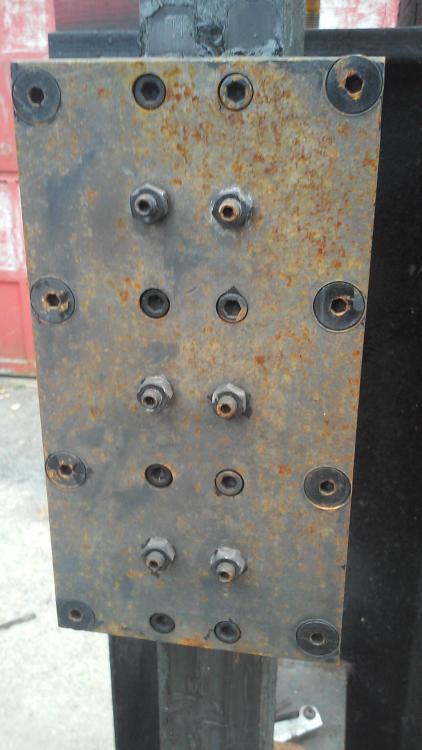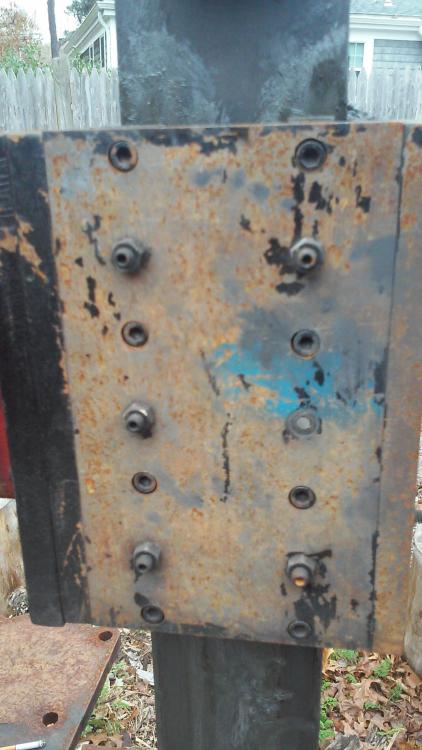
arftist
Members-
Posts
2,699 -
Joined
-
Last visited
Content Type
Profiles
Forums
Articles
Gallery
Downloads
Events
Everything posted by arftist
-
I got lucky and scored a stainless steel 30 gallon drum which has served me well. Another idea I have seen is an old vertical air compressor tank with the top cut off.
-
Forged Post Hole digging bar
arftist replied to Alan Evans's topic in Tools, ID, and pictorial reference
obviously it could break ice but the many that I have made and seen for breaking ice are about 4 inchs wide at the edge. -
Industrial Ajax Spring hammer HP?
arftist replied to Krush's topic in Power Hammers, Treadle Hammers, Olivers
240 blows per minute divided into 1730 RPM is 7.2 to 1 gear reduction. If you chose a jackshaft drive pully of 6"diameter you will have 3.5 to 1. (19÷6 =3.5) Since you have a 4" motor pulley and you need to incur an additional reduction of 3.7 to 1 multiply 4" x 3.7 to learn the diameter of the jackshaft driven pulley. -
Put it in your metal shop. Those saws cut very square and also very hard steel. I have a Marvel number 1. I will post a couple pics next chance I get.
-
The inside of the radious die needs to be significantly looser since the inside of the bend will thicken. The outside will become thinner so just a little clearance is needed.
-
Manipulating a big hammer, installation
arftist replied to Jspool's topic in Power Hammers, Treadle Hammers, Olivers
no access to the rafters? Hammer, etc many easy ways to break or remove sheetrock. -
Beginner to Known Steel
arftist replied to AR AnvilWorks's topic in Blacksmithing, General Discussion
forgable. Good for making tools. -
Sounds like tendonitis to me AKA the grip. Ice the heck out of it and cease all painful activities until healed.
-
Thank you
-
All of the above. We are forging 385 bronze right now and either we turn off the lights when heating the bars or they split like too cold wrought iron. I know from the last time I did this though, that a lazer guided digital pyrometer ( arround $50) will also enable me to stay within forging temp easily.
-
Lots of potential reasons but we could start with eye-hand coordination. Either you have good eye-hand coordination or you don't.
-
It is a fact that only 10% of the population has the ability to focus well enough to be competent welders....I wonder if there is corresponding info about forging.
-
My first Bridgeport had a 30" table and a round ram with a J head. Later I bought a much newer machine with a 48" table and power feed but no head. The round ram J head fit but was missing the head rotation gear. Eventually I put a much newer J head on it as well.
-
bear in mind that you can roll thicker pieces of narrower stock. For example you may be able to roll 11 gauge 4" wide or 1/4 x1" or 5/ 16" round Heavy bends should be done at the ends of the rolls.
-
Sher, Shea or sheb anvil dated 1896
arftist replied to Frank1967's topic in Anvils, Swage Blocks, and Mandrels
I can't tell either. If I had to guess though, I' d say it is a Fisher made in 1896. Darned good anvil if it isn't beat up too bad. can't tell that either. -
Designing a 50lb guided helve hammer.
arftist replied to tylerdewitt's topic in Power Hammers, Treadle Hammers, Olivers
method of riggng foot petal without springs the pivot point must be placed where the idler wheel end is heavey enough to return on it's own. -
Designing a 50lb guided helve hammer.
arftist replied to tylerdewitt's topic in Power Hammers, Treadle Hammers, Olivers
guide box other veiw this shows the adjustment side slide adjustment the socket head bolts thread into the bronze guides. The set screws with lock nuts thread into the box and end in blind clearance holes drilled in the bronze. -
To avoid the notch effect a transition in size should be gradual and smooth. .
-
read about the notch effect.
-
Dick, Welcome to Mass Tim Miller spoke highly of you. I currently have a temp shop set up at a jobsite in Taunton. Would love to meet, see, get to know another member. Send me a PM for contact info if interested. Thanks.
-
Williams Coal and Oil Braintree Mass
-
building a mechanical forging hammer
arftist replied to MG-42's topic in Power Hammers, Treadle Hammers, Olivers
Too many incorrect assumptions to bother with, sorry. This has all been covered in detail in this forum, search, read back or continue in ignorance as you desire. Trying to directly compare a cast machine to fabricated machine just doesn't work, any better than a bolt on top plate compared to a welded on top plate. Other than the lack of a flywheel with a flat belt clutch and a solid anvil this fellow has made a nice machine. It would be a waste of time and materials to not replace the anvil asap. I am a commercial smith so perhaps I don't understand why one would build an extravagant machine to move metal "easier than a handhammer" but common sense tells me any user would want decent performance and since there isn't a sow block there needs be a solid anvil. Finally I would point out that three previous posters suggested the same thing yet you find my comment odd. The most important thing in this is NOT saving the cutting a few welds, it is the creation of a most usable machine not a barely usable machine.. To reiterate: commercial cast hammers have a solid sow block, fabricated anvils use a solid steel anvil post instead. Not a hollow anvil post. -
building a mechanical forging hammer
arftist replied to MG-42's topic in Power Hammers, Treadle Hammers, Olivers
Bear in mind that though very popular, Little Giant hammers were the low end of power hammers when they were built. Serious hammers were 20-1 anvil to tup ratio, and no, it isn't worth trying it with a hollow anvil. Read up instead. With one piece hammers, the entire hammer frame adds inertia. There are no two piece hammers with hollow anvils that I am aware of. -
How can I tame my tire hammer?
arftist replied to setlab's topic in Power Hammers, Treadle Hammers, Olivers
Blows per minute; motor RPM divided by reduction ratio. The reduction ratio is calculated by dividing the diameter of the driven pulley by the diameter of the drive pulley. Example; 2 inch drive pulley divided into 20 " diameter driven pulley is 10-1 motor RPM 1725 divided by 10 is 172 or 172 blows per minute. If the thing is really as out of control as you say, chances are you have a 3600 rpm motor and the only cure is a 1725 motor. The tup is the hammer itself 50# plus dies. It matters because smaller hammers strike faster. Your hammer should likely run about 250-300 BPM My 75 pound hammer runs about 210 blows per minute. -
building a mechanical forging hammer
arftist replied to MG-42's topic in Power Hammers, Treadle Hammers, Olivers
Second third or forth on installing a solid anvil.



